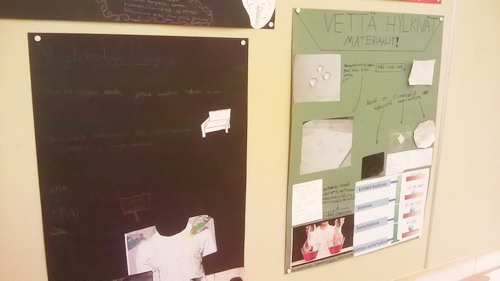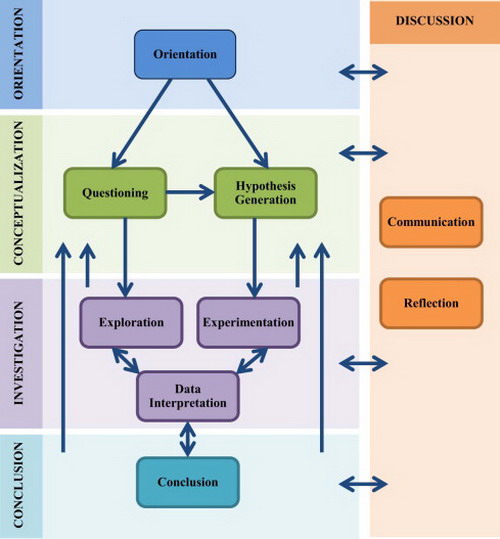Already during the planning stages of the project, we chose to implement the 5E model of inquiry by Bybee et al. (2006) as a big part of the structure in the developed learning environments. The choice would guide the production of learning environments by the Communities of Learners and ensure that the students learning with our materials would have an idea of how to conduct a scientific study.
From 5E to 6E
The 5E method has different steps – although it is not required to pass through the steps in a linear fashion. The first three E’s (Engage, Explore, Explain) are based on acquiring and meaning-making of content knowledge. The last two steps (Elaborate, Evaluate) offer support for discussions of RRI issues and the validity of scientific practices involved in the earlier steps.
Something familiar to the IRRESISTIBLE project seems to be missing!
How do we acknowledge the efforts of students in sharing their results, broadcasting their learning, and taking steps to inform the community about the main results or problems they pinpointed in their learning environment?

Figure 1. Primary school students’ communication of results on water repellency.
We decided to add an extra E, for Exchange. Exchange validates the students’ work to communicate and present the highlights of their work – and indeed this is a huge part in what scientists “actually” do! The students will learn that devising an exhibition means asking questions, using logic and evidence in formulating and revising explanations, recognizing and analyzing alternative explanations, and communicating the scientific arguments.
A general model of inquiry-based science education
How do the 6 E’s stand amidst the various ways of realizing inquiry-based science education (IBSE)?

Figure 2. Inquiry-based learning framework (general phases, sub-phases, and their relations). From Pedaste et al. (2015)
The framework shown in Figure 2 is from a large systematic review of various IBSE learning models by Pedaste et al. (2015). It reflects a contemporary view of inquiry-based learning. It contains the idea that the inquiry-based learning may involve going back and forth and taking different routes through the main “phases”. A difference to some earlier frameworks of IBSE is that it includes the meta-cognitive processes, required in e.g. the reflection and the transformative (such that transform information) phases.
As we compare with the Irresistible 6E model, we find that some phases named in Figure 2. appear hidden. It almost looks like the 6E model has no “Conceptualization” phase! With closer look, we find that in the 6E model, the conceptualization has been written into the E of Exploration. Similarly interpreting data and making conclusions are found under Elaborate; reflection belongs under Evaluate.
Experimentation is the only large difference: it is intentionally left out of the 6E – not all inquiry-based student work needs to be an experiment; many modules include experimental work, whereas some modules include tasks that are more appropriately addressed by reviewing literature or evaluating statements. The review treats it – in the article, it’s called a ‘data-driven approach’ – as one of the three main pathways through an inquiry-based science project.
All the other sub-phases of the model are seen as critical parts of the Irresistible 6E model.
One, two, three of E’s, four of E’s, rock
It’s an interesting task to compare different learning models based on Bybee et al. (2006): there are only minute differences to be found – unsurprisingly, they all follow along the big model of IBSE outlined above, with some features highlighted more than others.
Here we show a few examples for the reader to become familiar with, and to further a point: the IBSE models all steer the students towards one way of approaching science, and that is the main reason for using any of those. The highlighted features add flavor, but never disrupt the inquiry process. The 6Es of Irresistible, therefore, are perfectly suitable for use in your classroom – even if you were more familiar with one of the other 5 or 6E models to begin with!
The Full-Day Early Learning – Kindergarten Program (Ontario Ministry of Education, 2010)
The Ontario kindergarten program includes an outline of the inquiry process for small children. Its elements are the Engagement, Exploration, Investigation and Exchange. The exploration phase consists of observations and the investigation phase of sense-making activities around the observations; purposeful experimentation is not included in the inquiry process for small children.
6-E Learning Model with E-search (Chessin & Moore, 2004)
This model is the standard 5E enriched with an additional E for E-search; it incorporates technology in the exploration and engagement phases. Some descriptions of E-Search are quite similar to what goes by Exchange in Irresistible – there are suggestions to contact other schools or researchers by e-mail, for example. The E-search component could also support the evaluation phase with comparisons to other schools’ results.
6E Learning byDeSIGN™ Model (Burke, 2014)
In the DeSIGN model, the inspiration to add engineering to the original 5E has come from the entry of the Next Generation Science Standards, which support activities such as design, modeling, systems analysis, or human-computer-interaction. The 6 E’s of the model are Engage, Explore, Explain, eNGINEER, Enrich, and Evaluate.
References
- Burke, B .N. (2014). The ITEEA 6E Learning byDeSIGN™ Model, Maximizing Informed Design and Inquiry in the Integrative STEM Classroom. Technology and Engineering Teacher 73 (6), 14-19.
- Bybee, R. W., Taylor, J. A., Gardner, A., Van Scotter, P., Powell, J. C., Westbrook, A., & Landes, N. (2006). The BSCS 5E instructional model: Origins and effectiveness. Colorado Springs, CO: BSCS, 5, 88-98. Retrieved from http://bscs.org/sites/default/files/_legacy/BSCS_5E_Instructional_Model-Full_Report.pdf
- Chessin, D. A., & Moore, V. J. (2004). The 6-E Learning Model. Science and Children, 42, 3. Retrieved from http://science.nsta.org/enewsletter/2005-05/sc0411_47.pdf
- Ontario Ministry of Education (2010). The Full-Day Early Learning – Kindergarten Program. Retrieved from http://www.edu.gov.on.ca/eng/curriculum/elementary/kindergarten.html
- Pedaste, M., Mäeots, M., Siiman, L. A., de Jong, T., van Riesen, S. A., Kamp, E. T., ... & Tsourlidaki, E. (2015). Phases of inquiry-based learning: Definitions and the inquiry cycle. Educational research review, 14, 47-61.








